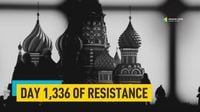The northern Ukrainian city of Chernihiv and its surrounding region have been plunged into darkness and uncertainty after a fresh wave of Russian attacks on energy infrastructure, highlighting the intensifying struggle for basic necessities as winter approaches. On the evening of October 20, 2025, Russian forces targeted key facilities, causing widespread blackouts, water shortages, and communication disruptions for hundreds of thousands of residents, according to multiple reports from suspilne.media, Reuters, and local authorities.
The aftermath was immediately felt on the morning of October 21, as much of Chernihiv awoke to a city without power, with only faint hope of a quick return to normalcy. "The situation in the city’s power sector remains critical and it is currently impossible to predict when electricity will be restored," Dmytro Bryzhynskyi, head of the Chernihiv City Military Administration, told reporters, as cited by suspilne.media. Energy workers have been laboring around the clock, but their efforts are hampered by the persistent threat of Russian drones circling above the damaged facilities, making even emergency repairs a dangerous gamble.
The blackout's impact rippled through every facet of daily life. Residents described scenes of long queues at the city’s 22 public "Points of Invincibility"—makeshift hubs offering free electricity, warmth, and water, staffed by police and emergency personnel. "Many people come to the Points of Invincibility, waiting in lines to charge their phones," said Natalia, a local resident, highlighting the desperate need to stay connected in a city where the mobile signal and internet had all but vanished. For Liubov, another resident, the lack of electricity and water meant a journey across the city just to charge her phone and power bank. "I live on the first floor; I still have some water, but when people live on the eighth or ninth floors there is no water. From the fifth floor there is no water anymore," she explained.
Water shortages have been particularly acute for those living in high-rise buildings. The Chernihiv water utility, now reliant on alternative power sources, reported that water could be supplied up to the fourth or fifth floors on average, and in some neighborhoods like Sherstyanka, up to the sixth floor. "All water facilities are at work, the wastewater system is fully operational. Water is supplied to the first stories, up to the fourth-fifth stories on average. In some neighborhoods, Sherstyanka in particular, [the water reaches] the sixth floor," the utility stated, as reported by Reuters.
With the city’s grid overloaded and rolling blackouts stretching beyond scheduled hours, authorities have urged residents to conserve electricity and refrain from sharing photos or details about strike sites or utility status, warning that such information can aid Russian targeting. The city’s vulnerability is compounded by its proximity to the Russian and Belarusian borders, making it a frequent target for missile and drone strikes. A former government official, speaking to Reuters on condition of anonymity, suggested that Chernihiv's energy facilities are particularly susceptible due to their location and insufficient protection.
The crisis has also forced significant adjustments in daily routines. Schools and kindergartens briefly moved to remote learning earlier in October, and as the blackout persisted, some educational institutions organized rotating groups to accommodate children. "The situation is very difficult. The kindergarten is not operating, we have no electricity for almost a day. And, unfortunately, we have to go somewhere in the city to find a signal, at least to call relatives," said a local parent, describing the growing sense of isolation.
Inside apartments, the lack of heat has left families shivering. "It’s cold in the apartment. We managed to warm it a little with a heater in the evening, but the power went out, so by morning it was very cold in the apartment. Dampness in the apartment, in the corners there’s dampness," Alina, a resident, recounted to suspilne.media. Businesses, too, have scrambled to adapt; local entrepreneur Yaroslav Kyrychenko described investing in a 6.5 kW generator to keep his establishment running. "It is absolutely essential for us to have power at our workplace. Therefore, we bought a 6.5 kW generator to ensure the business operates. We will work to the end and are ready to endure all difficulties," he said.
Officials at every level have acknowledged the gravity of the situation. The State Emergency Service reported that, as of October 21, 11 stationary and six mobile Points of Invincibility were operational in the city, and emergency services were working tirelessly to restore networks and ensure residents’ basic needs. Ukrenergo head Vitaliy Zaichenko expressed hope that electricity restoration in the region could be achieved within the day, though as of the morning, the full restoration time remained uncertain.
On the national stage, Ukrainian leaders have been quick to condemn Russia’s tactics. President Volodymyr Zelenskiy stated, "Russia’s tactics are to murder people and terrorise them with the cold," in a message on Telegram, underscoring the deliberate nature of the attacks as winter looms. Foreign Minister Andrii Sybiha echoed this sentiment, noting, "Many communities have been left without power amid cold autumn temperatures, some have been left without water." The Ukrainian energy ministry accused Russia of deliberately prolonging the humanitarian crisis by using drones to hinder repair efforts, stating, "Emergency crews in the Chernihiv region are unable to begin work on restoring power supply due to continuous attacks by Russian drones."
Chernihiv’s acting mayor, Oleksandr Lomako, sought to rally the city’s resilient spirit, recalling the early days of the full-scale invasion: "We overcame in February-April 2022. We will overcome now." But the challenge remains steep. Since early October, when a drone strike on a facility in nearby Slavutych triggered the first wave of outages, the city has faced rolling blackouts, water shortages, and heating shutdowns. Street lighting remains off to conserve power, and the grid is so fragile that some areas are disconnected beyond scheduled hours to prevent a total collapse.
Meanwhile, the broader diplomatic context remains fraught. While U.S. and Russian officials have discussed possible summits and negotiations, the Institute for the Study of War observed, "No indications that the Kremlin remains willing to accept anything less than Ukrainian capitulation to all of its original war demands," suggesting that the path to peace is as uncertain as the restoration of Chernihiv’s power supply.
As repairs continue under the constant threat of renewed attacks, Chernihiv’s residents are left to adapt, queue, and persevere—finding warmth where they can, and hoping for the lights to return before the true chill of winter sets in.

